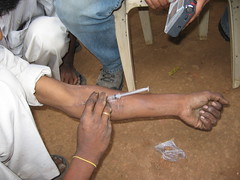We spent about seven hours at a drop-in center, right outside Central Station in Mumbai. The team interviewed seven drug users, and one staff member. Splitting off into pairs, the team asked general questions about what prison conditions were like in Mumbai, how guards treated inmates, how overcrowded were the prisons, and more. Several items ran consistent throughout all of the interviews.
 First, almost every interviewee made clear that drug use is rampant inside prisons, and is often steered by mafia-type bosses who control the flow of drugs inside and outside of the prison gates. (Staff members also indicated that if prisoners themselves had money, it was easy for them to get drugs from the outside.) Second, medical care inside prisons is severely inadequate. Two former prisoners, released just a few weeks ago, made a point of saying that there might be two doctors for the entire jail (which holds about 500-700 inmates). The doctors also only practice for about an hour a week, if that, according to most of those interviewed. And every person that our team spoke with said that prison doctors all deal with illness the same way: whether you have a headache, a fever, stomach ache, rash or more, you are given one pill, the same pill for any condition. (*Note: in this picture, it's not actually a guy injecting drugs. It's a staff member of the drop-in center, demonstrating how users inject themselves.)
First, almost every interviewee made clear that drug use is rampant inside prisons, and is often steered by mafia-type bosses who control the flow of drugs inside and outside of the prison gates. (Staff members also indicated that if prisoners themselves had money, it was easy for them to get drugs from the outside.) Second, medical care inside prisons is severely inadequate. Two former prisoners, released just a few weeks ago, made a point of saying that there might be two doctors for the entire jail (which holds about 500-700 inmates). The doctors also only practice for about an hour a week, if that, according to most of those interviewed. And every person that our team spoke with said that prison doctors all deal with illness the same way: whether you have a headache, a fever, stomach ache, rash or more, you are given one pill, the same pill for any condition. (*Note: in this picture, it's not actually a guy injecting drugs. It's a staff member of the drop-in center, demonstrating how users inject themselves.)Prisoners also mentioned forced sex, rival gang violence, lack of water, and lack of comfortable sleeping conditions as major problems within Mumbai’s prisons. Many of the stories were difficult, and offered a glimpse of what it looks like within the walls of India’s prisons.
 We also had the opportunity to sit in on a narcotics anonymous meeting, and two members of the team spoke with a drop-in house coordinator, who showed a diagram of how drug users inject themselves (what is commonly referred to as “fixing”). He also showed us an area directly next to the shelter, buttressed against the train station, where dozens of men were injecting themselves.
We also had the opportunity to sit in on a narcotics anonymous meeting, and two members of the team spoke with a drop-in house coordinator, who showed a diagram of how drug users inject themselves (what is commonly referred to as “fixing”). He also showed us an area directly next to the shelter, buttressed against the train station, where dozens of men were injecting themselves. It was a challenging and emotional day, but the seven hours spent interviewing the former inmates offered quite an insight into both the drug culture but also the prison culture within Mumbai.
We finished the evening by stopping by a concert for sex workers, organized by the Gates Foundation (Richard Gere was in attendance, too!), and a full-team meeting that lasted until just after midnight.
